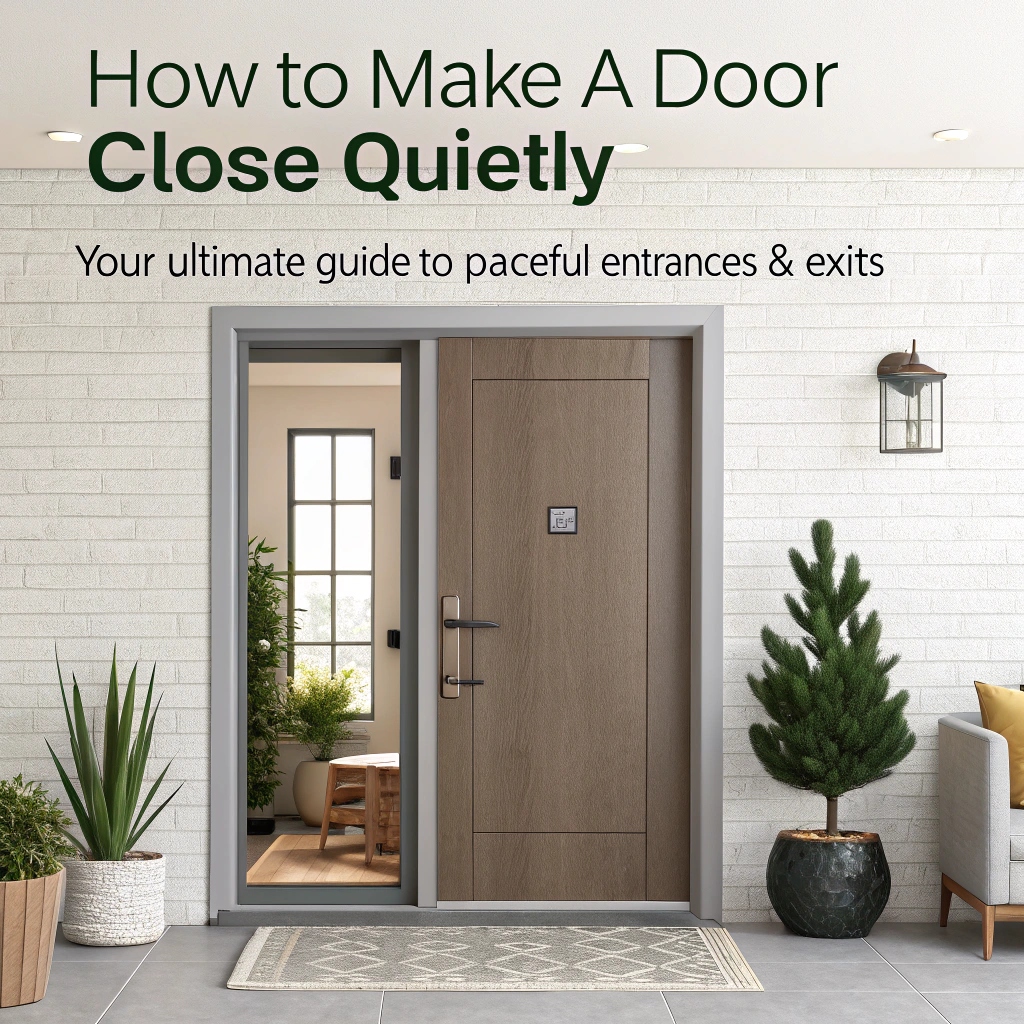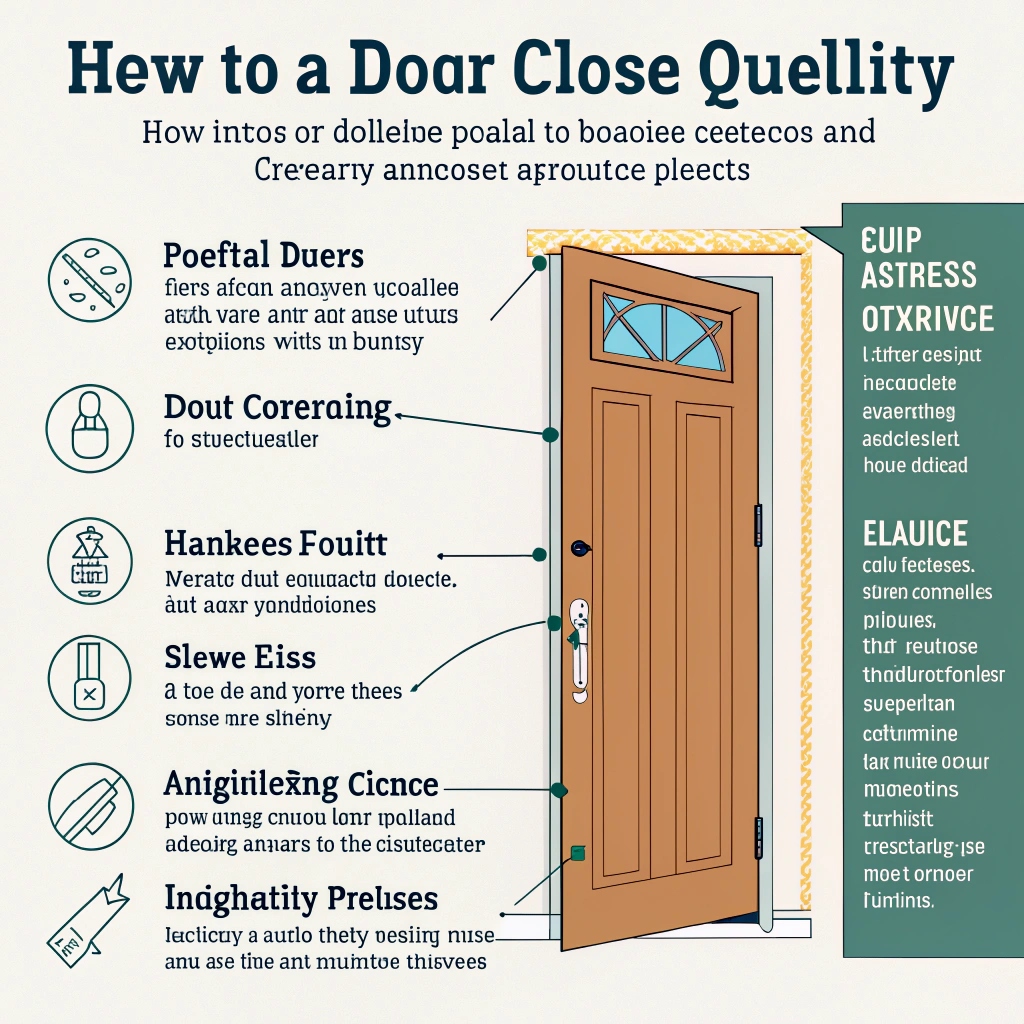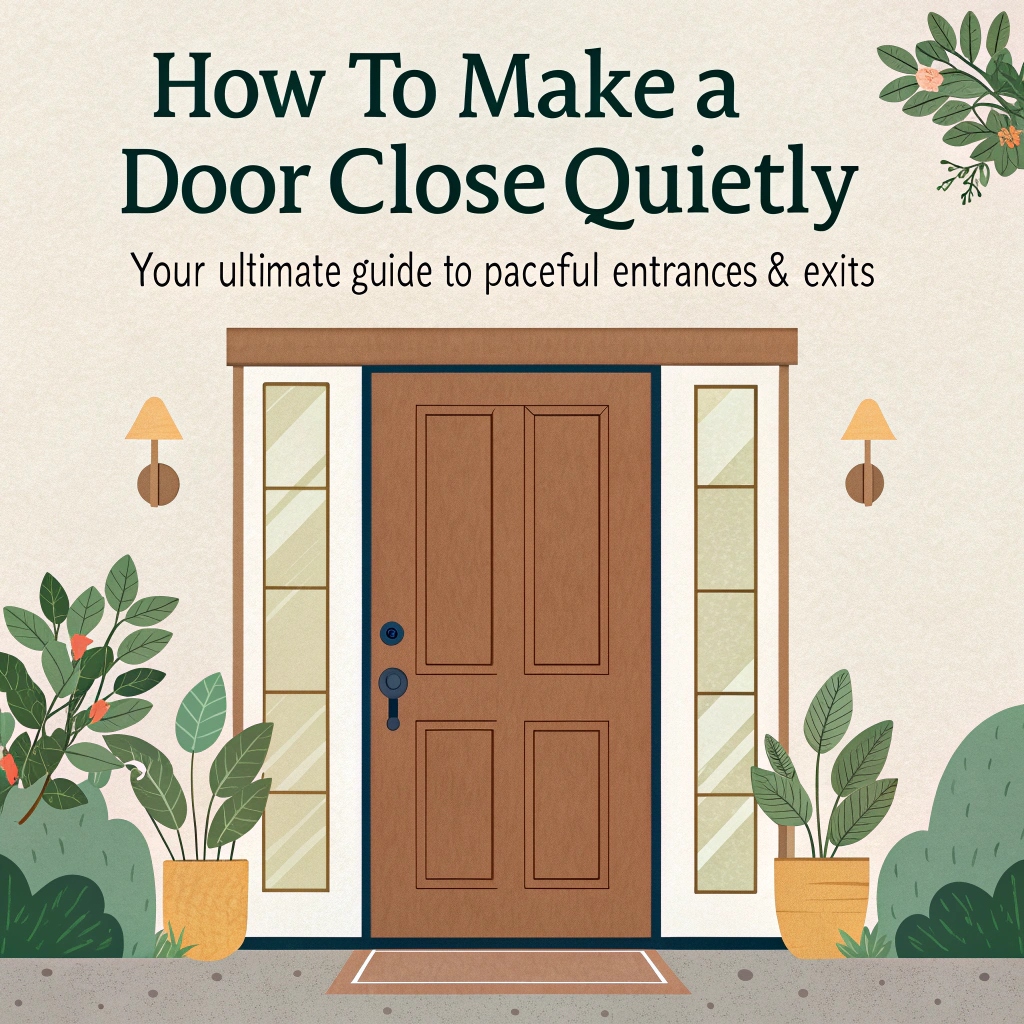- Mon - Sat 8:00 - 6:30, Sunday - CLOSED
- support@soundproofhub.com
How to Make a Door Close Quietly

How to Make a Door Close Quietly
That sudden SLAM! – it’s jarring, disruptive, and often completely avoidable. Whether it’s a bedroom door waking a sleeping baby, a front door announcing your late arrival, or a squeaky hinge driving you crazy, learning how to make a door close quietly is a simple yet transformative home improvement skill. This guide covers everything from basic adjustments to specialized hardware, helping you achieve a peaceful door quiet close.

Why Do Doors Slam or Make Noise?
Understanding the problem is the first step to a solution. Common culprits include:
-
Faulty or Missing Door Closer: The primary device controlling the door’s swing speed is broken, misadjusted, or absent.
-
Worn or Dry Hinges: Lack of lubrication causes grinding and squeaking during movement.
-
Loose Hardware: Screws in hinges, closers, or strike plates can rattle.
-
Excessive Air Pressure: Strong drafts rushing through gaps can literally suck or push doors shut forcefully.
-
Improper Latch Alignment: The latch scraping against the strike plate creates noise.
-
Lack of Cushioning: No soft stop prevents the door handle or edge from hitting the wall or frame hard.

Step 1: Diagnose Your Noisy Door
Before grabbing tools, identify the type of noise and when it happens:
-
Loud Slam at the End of the Swing? Focus on the door closer (if present) or installing one.
-
Squeaking/Grinding During Movement? Target the hinges.
-
Rattling or Clicking? Check for loose screws in hinges, closers, or strike plates.
-
Click/Scrape When Latching? Inspect the latch and strike plate alignment.
-
Thud Against the Wall? You need a door noise stop.
Step 2: Adjust or Install a Quiet Door Closer
This is often the most effective fix for slamming doors. Closers control the swing speed and latch speed.
-
Adjusting an Existing Closer:
-
Locate the adjustment valves (usually two screws marked “Sweep” and “Latch”).
-
Sweep Speed: Controls the main swing from open to about 15 degrees closed. Turn clockwise to slow down (quieter), counter-clockwise to speed up.
-
Latch Speed: Controls the final few inches of closing. Turn clockwise to slow down (prevents slam), counter-clockwise to speed up.
-
Make small adjustments (1/8 turn at a time) and test the door repeatedly.
-
-
Choosing & Installing a New Quiet Door Closer:
-
Look for “Quiet Close” or “Soft Close” features: Brands like Norton, LCN, or Sugatsune specialize in smooth operation.
-
Types:
-
Overhead Closers: Common for exterior and commercial doors. Mount on the door frame/top of door. Choose adjustable models.
-
Floor Closers: Hidden in the floor, ideal for aesthetics. Often found on glass doors.
-
Perco/Pivot Closers: Integrated into the hinge pivot point, very discreet.
-
Hydraulic Door Closers: Offer excellent, smooth control. Search quiet close door hinges for integrated pivot options.
-
-
Consider Door Weight & Size: Closers are rated for specific door weights. Match yours correctly.
-
Installation: Follow manufacturer instructions meticulously. Proper alignment is crucial for quiet operation and longevity.
-

Step 3: Silence Squeaky Hinges
Dry metal-on-metal friction is a classic noise maker.
-
Tighten Hinge Screws: Use a screwdriver to secure every screw on all hinges (door and frame side). Loose screws cause movement and noise.
-
Lubricate! This is key for how to make a door quiet when it closes:
-
Best Lubricants: Dry lubricant (Teflon spray, graphite powder), light machine oil (3-in-1 oil), or silicone spray. *Avoid WD-40 for long-term lubrication; it dries out quickly.*
-
Method: Apply lubricant to the hinge pin. The best way is to partially lift the pin out (tap it upwards from the bottom with a nail and hammer) and apply lubricant directly. If pins won’t budge, spray/apply lubricant generously into the knuckle gaps at the top and bottom of each hinge while working the door open and closed.
-
Wipe Excess: Prevent drips onto flooring.
-
Step 4: Ensure Smooth Latching
A scraping latch is annoying and can damage hardware over time.
-
Check Alignment: Does the latch hit the strike plate dead center? Close the door slowly and watch.
-
Adjust the Strike Plate:
-
If the latch is hitting too high/low, slightly enlarge the strike plate hole vertically using a metal file.
-
If hitting the side, loosen the strike plate screws, shift the plate slightly towards the misalignment, retighten, and test.
-
-
Lubricate the Latch: Apply a small amount of dry lubricant (graphite powder is ideal) into the latch mechanism hole in the edge of the door.
Step 5: Seal Drafts & Reduce Air Pressure
Strong drafts can pull doors shut forcefully.
-
Install Weatherstripping: Apply adhesive-backed foam or rubber weatherstripping around the door jamb where the door meets it when closed. This creates an airtight seal, preventing drafts that cause slamming and improving energy efficiency. A well-sealed door often closes more gently.
-
Consider an Under-Door Draft Stopper: While primarily for drafts and sound, a dense stopper can also slightly cushion the door’s final movement.
Step 6: Add Cushioning with Door Stops
Prevent the doorknob or door edge from hitting the wall or adjacent cabinetry.
-
Wall-Mounted Stops: Install a rubber or felt bumper on the wall or baseboard where the knob hits. Ensure it’s positioned correctly for the door’s arc.
-
Floor-Mounted Stops: A simple rubber or spring-loaded stop on the floor behind the door swing path.
-
Hinge-Pin Stops: Small rubber bumpers that slide onto the hinge pin itself, limiting how far the door can open. Useful for preventing contact with walls directly behind the hinge side.
Special Cases: Cars, Screen Doors & Cabinets
-
How to Close a Car Door Quietly:
-
Lubricate: Hinges and latch mechanisms (use automotive-specific lubricant).
-
Check Weatherstripping: Damaged or worn door seals won’t cushion the close. Replace if needed.
-
Technique: Push the door firmly until it’s almost closed (about 1-2 inches from the frame), then give a final, gentle push to latch it. Avoid the “slam” momentum. Search make car door close quieter for vehicle-specific tips.
-
-
How to Make a Screen Door Close Quietly:
-
Adjust the Closer: Most screen/storm doors use a pneumatic closer (cylinder). Adjust the tension screw (usually on the end) – turn clockwise to increase closing force/speed, counter-clockwise to decrease (slower/quieter). Look for a quiet storm door closer if replacing.
-
Lubricate Hinges & Latch.
-
Check for Binding: Ensure the door isn’t rubbing against the frame.
-
-
Cabinet Door Quiet Close: This is achieved with specialized quiet close cabinet door hardware – dampers or mechanisms integrated into the hinges or mounted inside the cabinet that absorb the final closing force. Installing these is the solution, not adjusting standard hinges.

When Signage is the Solution: The “Close Door Quietly” Sign
Sometimes, the noise source is human! For shared spaces, offices, or homes with forgetful family members:
-
Placement: Mount a close door quietly sign prominently on the door itself (eye level) or on the adjacent wall.
-
Design: Choose clear, polite wording (“Please Close Door Quietly,” “Shhh… Quiet Closing Please”) and consider friendly visuals (like a smiley face). Options include adhesive decals, acrylic signs, or printed cards.
-
Find Them: Search please close door quietly sign or close the door quietly sign online retailers.
FAQ: Your Quiet Door Questions Answered
Q1: Can I make ANY door close quietly?
A: Most standard interior and exterior doors can be significantly quietened using the methods above (closer adjustment, lubrication, alignment). However, very heavy or poorly constructed doors might have inherent limitations. Fire doors often have specific closing speed requirements for safety and may not be adjustable to be completely silent.
Q2: Are “quiet close door hinges” worth it?
A: Absolutely, especially for interior doors where a traditional overhead closer is undesirable. Hydraulic or pivot-style quiet close door hinges provide a smooth, controlled, and silent closing motion right at the hinge point, offering a sleek look and excellent performance. Ideal for modern homes.
Q3: What’s the single most effective way to stop a door from slamming?
A: Installing or properly adjusting a quiet door closer is almost always the most effective solution. It directly controls the closing speed and force. Lubrication and alignment prevent other noises but won’t stop a door from slamming if the closing force is too high.
Q4: I tightened everything and lubricated, but my door still squeaks! What now?
A: The hinge pin itself might be worn or corroded. Try removing the pin completely (tap it out from the bottom), clean it thoroughly with a wire brush or solvent, lubricate it well (graphite powder is excellent for high-friction points), and reinsert it. If it’s badly worn, replace the hinge.
Q5: Can I make my microwave door close quietly?
A: Some higher-end microwaves feature quiet close microwave door mechanisms. For others, it’s trickier. You might be able to apply a tiny amount of silicone lubricant (check your manual first!) to the door latch mechanism, but avoid getting any on electrical components. Focus on gentle closing technique.
Q6: Where can I find a quiet close solution for my barn door?
A: Look for quiet close barn door hardware kits. These often include soft-closing dampers integrated into the track system or the hangers themselves, preventing the door from crashing into the end stops. Search for 2-side soft close quiet glide barn door hardware for options that cushion both ends.
Enjoy the Sound of Silence
Transforming a noisy slam into a gentle whisper is more than just a home repair; it’s an investment in tranquility. By diagnosing the cause, applying the right fix – whether it’s adjusting a quiet door closer, silencing hinges, aligning the latch, or installing a please close the door quietly sign – you can reclaim peace in every room. Start with simple lubrication and tightening, progress to closer adjustments, and don’t hesitate to invest in quality quiet close door hardware for a truly serene home environment. Close the door on noise for good!




Muhammad Zeeshan
Muhammad Zeeshan is an SEO expert specializing in link building (SaaS, Tech, Business, and Home Improvements). I am very passionate about search engine optimization, backlink building, and guest blogging. I can help you in attracting a new audience and in achieving a higher rating.